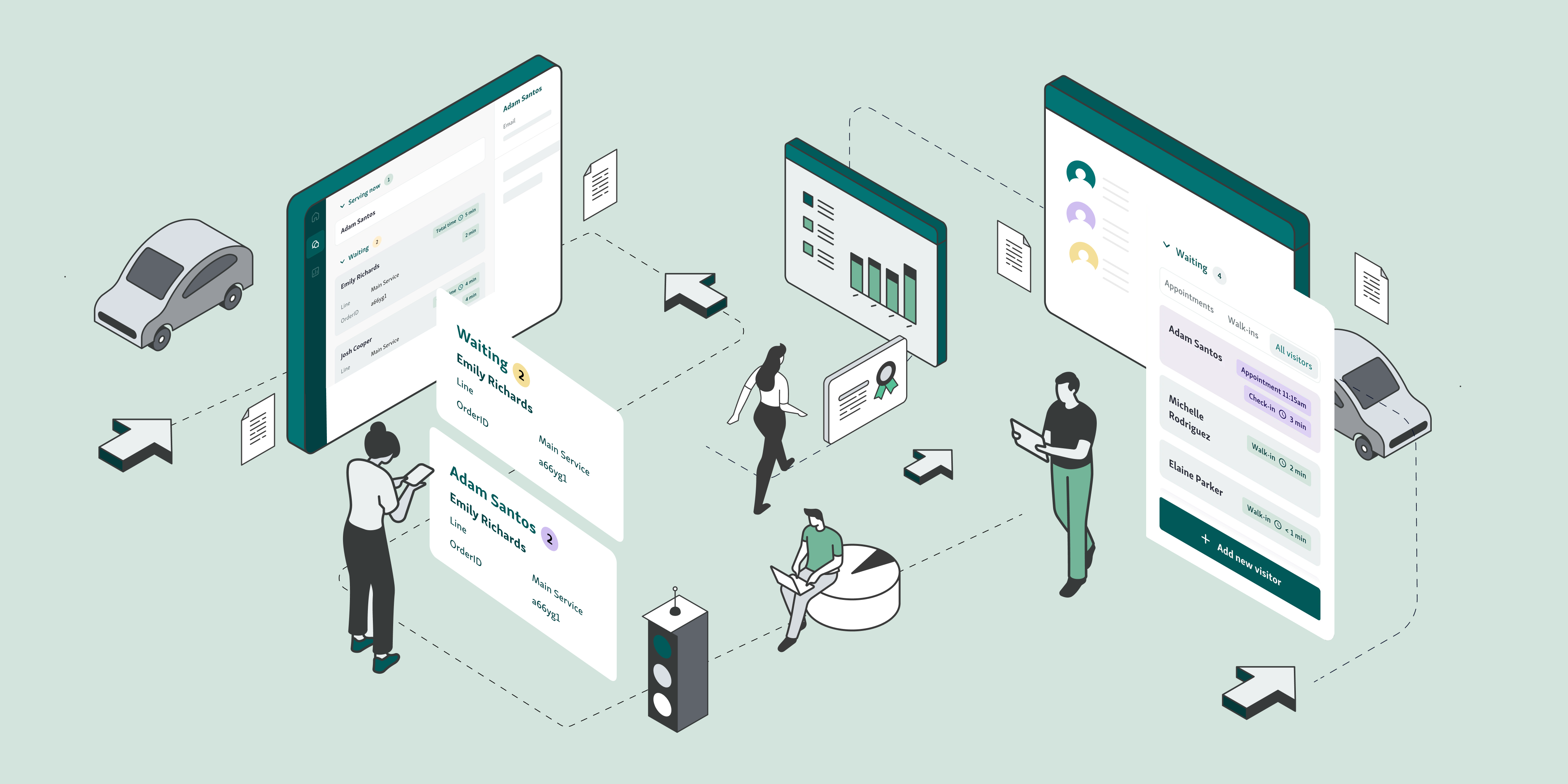FIFO queues are commonly used across various industries to maintain fairness and simplicity. By serving customers or tasks in the order they arrive, this method promotes transparency and ensures that everyone is treated equally.
Studies show that 73% of customers will abandon a purchase if they have to wait more than five minutes to check out or receive service. highlighting the significant role of FIFO in improving customer satisfaction through a fast-paced servicing method.
When customers perceive the queue system as fast, and fair, they feel more valued and are less likely to experience frustration, ultimately leading to a better overall service experience.
In this blog, we’ll break down what FIFO means, why it’s such a popular choice, and how it’s applied in different sectors to streamline operations and boost customer loyalty.
What is a FIFO Queue?
FIFO means "First In, First Out," which is a queue management system where the first item or person to enter the queue is the first to be served or processed. This method ensures that everyone is treated fairly, with the first to arrive getting served first, making it widely used in various industries to streamline operations.
In inventory management, FIFO is an approach where the oldest stock is sold or used first, ensuring that products do not remain unsold or unused for long periods. For example, in a grocery store, the first items placed on the shelves are the first to be sold to customers, preventing stock from expiring.
Where Do We See FIFO in Action?
FIFO, or First-In, First-Out queue, is used in various industries to streamline processes and improve customer satisfaction. Let’s take a look at some of the key areas where FIFO plays a crucial role.
1. Healthcare and Hospitals
In healthcare, FIFO helps manage patient flow in hospitals and clinics, ensuring that patients are seen in the order they arrive. This approach helps reduce wait times, minimizes overcrowding, and ensures timely care, which is especially critical in urgent care settings. By using FIFO, hospitals can allocate resources more efficiently and avoid overwhelming staff during peak times.
ER triage: Patients arriving first get seen before others, ensuring fair and timely attention.
Appointment scheduling: FIFO ensures appointments are honored in the order of booking, reducing delays.
Resource allocation: Medical staff are assigned based on patient arrival times, preventing bottlenecks.
You might also like - Best Practices for Healthcare
2. Government Services
FIFO is also used in government services, such as the DMV or municipal offices, where long lines and wait times are common frustrations. By serving citizens in the order they arrive, FIFO helps maintain fairness and reduces dissatisfaction. This method makes the process more predictable and transparent, creating a smoother experience for everyone.
DMV lines: People get served in the order they arrive, reducing complaints of unfair treatment.
Municipal services: FIFO helps allocate resources evenly across services like licensing or permits.
Taxpayer services: Reduces frustration by handling cases based on arrival time, not personal connections.
3. Retail and Food Service
In retail and food service, FIFO ensures that customers are served in the order they arrive, keeping queues moving efficiently. Whether it’s in a fast food chain, a restaurant, or a retail store, FIFO helps reduce the perception of wait times and keeps customers happy. This method also ensures inventory management is efficient, with older stock used before newer stock, benefiting both the customer and the business.
Fast food lines: Orders are filled in the order they are received, keeping service consistent.
Retail checkout: Customers waiting longest are processed first, ensuring fairness at the counter.
Grocery stores: FIFO ensures older stock is sold first, reducing waste and improving customer satisfaction.
Helpful read - Easy Steps for Good Retail Experience
Why FIFO Works So Well and Why It's Everywhere
FIFO or First-In, First-Out queue is an effective queuing method widely used across industries due to its simplicity and fairness. Here's why it works so well and why it is so popular:
FIFO Ensures Fairness
FIFO queuing guarantees that customers are served in the exact order they arrive, which fosters a sense of fairness. This system is designed to prevent shortcuts or line-jumping, making the queuing process feel transparent and unbiased. As a result, customers trust that everyone is receiving the same treatment, reducing frustration and complaints about unfairness.
Equal treatment: By serving customers in the order of their arrival, FIFO ensures no one is given priority, making the process feel just and equitable.
Transparent system: FIFO removes any ambiguity from the process, as everyone knows that the first person to arrive is the first to be served.
Happier Customers = Better Service
When customers feel they are treated fairly, it directly impacts their satisfaction and overall experience. FIFO helps build customer loyalty, as people are more likely to return to businesses where they feel respected and valued. A fair queue system leads to a better overall atmosphere, encouraging positive interactions.
Customer loyalty: Customers who experience fairness are more likely to trust the business and return for future services.
Positive word of mouth: Satisfied customers are likely to recommend the service to others, expanding the business’s customer base.
FIFO's Popularity
FIFO is widely used because of its simplicity and ease of understanding. The system is intuitive and can be applied seamlessly across various industries, from healthcare to retail. It doesn't require complex rules, making it easy for both businesses and customers to follow.
Because of its straightforward approach, FIFO can be quickly adopted by businesses of any size, ensuring minimal disruption to daily operations. The simplicity of FIFO allows businesses to implement it with minimal training, which helps streamline operations and improves overall customer satisfaction.
The Psychology of FIFO
FIFO also plays a significant role in reducing customer anxiety during the waiting process. When customers know that the queue operates fairly and that everyone is being treated equally, it makes the wait feel more predictable and manageable.
This sense of fairness calms customers, leading to reduced impatience and dissatisfaction. The certainty of the queue system helps customers feel that their wait is justified, and as a result, they are likely to perceive the wait time as shorter than they would in an unfair or unpredictable system.

FIFO vs Other Queuing Methods
FIFO is the most common and fair method for customer service, but other systems like Priority Queues or LIFO may be better for specific situations, such as urgent tasks or data handling. Each method has its strengths, depending on the context.
FIFO vs Priority Queues
FIFO ensures customers are served in the order they arrive, maintaining fairness, while Priority Queues allow customers to be served based on urgency or importance, which is often used in situations like healthcare or emergency services.
Key Differences:
FIFO serves customers in the exact order they arrive, while Priority Queue serves based on assigned priority levels.
FIFO is ideal for general service environments, whereas Priority Queue is better for urgent or high-priority cases like medical emergencies.
FIFO emphasizes fairness and simplicity, while Priority Queue allows for faster service for those in critical need.
FIFO wins because it ensures fairness by serving customers in the order they arrive, promoting transparency. While Priority Queues are useful for urgent situations, FIFO is a better fit for most service environments, ensuring that all customers are treated equally and without bias.
FIFO vs LIFO Queues
FIFO serves the first customer who arrives, ensuring fairness, while LIFO serves the most recent customer, which can create dissatisfaction in customer service settings as it may feel unfair to those who waited longer.
Key Differences:
FIFO serves the first customer to arrive, ensuring fairness, whereas LIFO serves the most recent customer first, which can lead to frustration.
FIFO is ideal for customer-facing services where fairness is critical, while LIFO is more suited for stack-based operations, such as in programming.
FIFO is widely preferred in retail and restaurants, while LIFO is used for operations involving stack-based management.
FIFO wins in customer service settings because it provides fairness by serving customers based on their arrival time. LIFO, while useful for stack-based tasks, can cause frustration in customer-facing environments as it disregards the order in which customers arrived. FIFO maintains a more predictable and positive experience for all customers.
Challenges with FIFO
While FIFO is a widely used and fair system, it does have its challenges, particularly in managing overcrowding and peak-time issues. During high-traffic periods, long queues can form, leading to frustration among customers.
On top of that, businesses may struggle to efficiently allocate resources during peak hours. These challenges can be addressed by implementing solutions like appointment queue software, offering flexible time slots, or integrating real-time queue management systems that can dynamically adjust based on demand.
Technology and FIFO: The Perfect Pair
Integrating technology with FIFO can enhance efficiency, streamline operations, and improve the customer experience. Tools like Qminder, mobile apps, and kiosks can make FIFO even more effective by reducing wait times, ensuring fairness, and boosting customer satisfaction.
The Role of Technology in FIFO
Modern digital tools, such as advanced queue management software, can enhance the effectiveness of FIFO by automating the process and making it more efficient. These technologies streamline queue management by tracking customer arrival times, predicting wait times, and allocating resources more effectively. As a result, FIFO becomes more precise and faster, ultimately improving service delivery and customer satisfaction.

Automates queue management for precise FIFO application.
Predicts wait times and allocates resources effectively.
Enhances service delivery by streamlining operations.
Benefits of Tech in FIFO
With real-time notifications and automated reminders, customers are kept informed about their position in the queue, reducing uncertainty and frustration. Self-check-ins and automated updates further ensure that customers have a seamless experience, enhancing service efficiency and making FIFO even more effective in high-traffic environments.

Real-time notifications keep customers informed.
Self-check-ins help customers bypass long lines.
Automated reminders reduce no-shows and waiting anxiety.
Also Read - How to set real-time notifications
Mobile Apps and Kiosks
Mobile apps and self-service kiosks play a crucial role in reducing long lines and wait times. These tech solutions allow customers to check in remotely or upon arrival, speeding up the queue process and minimizing congestion. By using these tools, businesses can maintain FIFO's fairness while also improving the overall customer experience, ensuring smooth operations.

Mobile apps allow for remote check-ins and status updates.
Kiosks help reduce waiting times by allowing self-check-ins.
Minimizes congestion and improves customer flow.
Read more - How Electronic Queuing Systems Improve Operational Efficiency
FIFO Queue Examples: Real-World Applications
FIFO queues are used in various sectors to improve efficiency and fairness. Below are some practical FIFO queue examples that demonstrate how this system operates in everyday settings:
1. Retail Checkout
In retail environments, FIFO ensures that the customer who has been waiting the longest gets served first. This method not only promotes fairness but also helps in managing customer expectations and reducing complaints about unfair treatment. For example, in a busy grocery store, FIFO helps customers move through checkout lines in the order of their arrival, ensuring a smooth and equitable shopping experience.
2. Healthcare and Hospitals
Hospitals and clinics use FIFO to manage patient flow, ensuring that those who arrive first are seen first. This is especially crucial in emergency rooms where prompt treatment can make a significant difference. For instance, patients arriving for scheduled appointments are seen in the order they were booked, reducing delays and improving patient satisfaction.
3. Government Services (e.g., DMV)
In government services like the DMV, FIFO is essential for managing long queues. Citizens are served in the order they arrive, preventing frustration from perceived favoritism. This system ensures that everyone is treated fairly and that service delivery is predictable, which is crucial for maintaining trust in public institutions.
4. Fast Food and Restaurants
FIFO is also common in food service industries. Whether in a fast-food chain or a sit-down restaurant, customers are served in the order of their arrival. This helps maintain fairness and reduces the perception of long wait times, improving the overall dining experience. Additionally, FIFO is used in managing inventory, ensuring that older stock is used before newer items, reducing waste and improving food quality.
Why FIFO Should Be Your Go-To Queue Method
FIFO offers a straightforward, fair, and effective approach to queue management, making it the ideal choice for many industries.
Its simplicity and transparency create a positive customer experience, while its adaptability ensures it works across diverse settings, from retail to healthcare. By eliminating confusion and promoting fairness, FIFO helps businesses reduce customer frustration and improve satisfaction.
The integration of technology, such as queue management systems, further enhances FIFO’s benefits, reducing wait times and streamlining operations.
For a seamless FIFO experience that boosts both customer and staff satisfaction, consider using Qminder, a queue management tool designed to optimize your service delivery and improve overall operational efficiency.
FIFO manages high traffic by ensuring customers are served in the exact order they arrive, preventing bottlenecks. Peak periods can be addressed with a mix of efficient resource allocation and additional staff during busy times.
FIFO is highly effective in industries like healthcare, retail, banking, and government services, where fairness and predictable service delivery are critical to customer satisfaction.
FIFO streamlines the service process, reducing confusion and improving workload distribution. Employees can focus on serving customers in a structured order, which helps reduce stress and improves overall efficiency.






